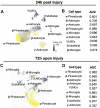Profiling Temporal Changes of the Pineal Transcriptomes at Single Cell Level Upon Neonatal HIBD
- PMID: 35350377
- PMCID: PMC8958010
- DOI: 10.3389/fcell.2022.794012
Profiling Temporal Changes of the Pineal Transcriptomes at Single Cell Level Upon Neonatal HIBD
Abstract
Neonatal hypoxic-ischemic brain damage (HIBD) often results in various neurological deficits. Among them, a common, yet often neglected, symptom is circadian rhythm disorders. Previous studies revealed that the occurrence of cysts in the pineal gland, an organ known to regulate circadian rhythm, is associated with circadian problems in children with HIBD. However, the underlying mechanisms of pineal dependent dysfunctions post HIBD remain largely elusive. Here, by performing 10x single cell RNA sequencing, we firstly molecularly identified distinct pineal cell types and explored their transcriptome changes at single cell level at 24 and 72 h post neonatal HIBD. Bioinformatic analysis of cell prioritization showed that both subtypes of pinealocytes, the predominant component of the pineal gland, were mostly affected. We then went further to investigate how distinct pineal cell types responded to neonatal HIBD. Within pinealocytes, we revealed a molecularly defined β to α subtype conversion induced by neonatal HIBD. Within astrocytes, we discovered that all three subtypes responded to neonatal HIBD, with differential expression of reactive astrocytes markers. Two subtypes of microglia cells were both activated by HIBD, marked by up-regulation of Ccl3. Notably, microglia cells showed substantial reduction at 72 h post HIBD. Further investigation revealed that pyroptosis preferentially occurred in pineal microglia through NLRP3-Caspase-1-GSDMD signaling pathway. Taken together, our results delineated temporal changes of molecular and cellular events occurring in the pineal gland following neonatal HIBD. By revealing pyroptosis in the pineal gland, our study also provided potential therapeutic targets for preventing extravasation of pineal pathology and thus improving circadian rhythm dysfunction in neonates with HIBD.
Keywords: astrocyte; hypoxic-ischemic brain damage; microglia; pineal gland; pinealocyte; pyroptosis; single cell RNA sequencing.
Copyright © 2022 Ding, Pan, Tian, Huang, Hayashi, Liu, Li, Xu, Miao, Yang, Sun, Feng, Feng, Li and Huang.
Conflict of interest statement
The authors declare that the research was conducted in the absence of any commercial or financial relationships that could be construed as a potential conflict of interest.
Figures







Similar articles
-
The role of pineal microRNA-325 in regulating circadian rhythms after neonatal hypoxic-ischemic brain damage.Neural Regen Res. 2021 Oct;16(10):2071-2077. doi: 10.4103/1673-5374.308101. Neural Regen Res. 2021. PMID: 33642396 Free PMC article.
-
The role of a lncRNA (TCONS_00044595) in regulating pineal CLOCK expression after neonatal hypoxia-ischemia brain injury.Biochem Biophys Res Commun. 2020 Jul 12;528(1):1-6. doi: 10.1016/j.bbrc.2020.05.047. Epub 2020 May 22. Biochem Biophys Res Commun. 2020. PMID: 32448507
-
[Expression profiles of miRNA-182 and Clock mRNA in the pineal gland of neonatal rats with hypoxic-ischemic brain damage].Zhongguo Dang Dai Er Ke Za Zhi. 2016 Mar;18(3):270-6. doi: 10.7499/j.issn.1008-8830.2016.03.016. Zhongguo Dang Dai Er Ke Za Zhi. 2016. PMID: 26975828 Free PMC article. Chinese.
-
Research advances in the role of endogenous neurogenesis on neonatal hypoxic-ischemic brain damage.Front Pediatr. 2022 Oct 10;10:986452. doi: 10.3389/fped.2022.986452. eCollection 2022. Front Pediatr. 2022. PMID: 36299701 Free PMC article. Review.
-
Localization and biological activities of melatonin in intact and diseased gastrointestinal tract (GIT).J Physiol Pharmacol. 2007 Sep;58(3):381-405. J Physiol Pharmacol. 2007. PMID: 17928638 Review.
Cited by
-
Microglia in Circumventricular Organs: The Pineal Gland Example.ASN Neuro. 2022 Jan-Dec;14:17590914221135697. doi: 10.1177/17590914221135697. ASN Neuro. 2022. PMID: 36317305 Free PMC article. Review.
-
Sex-Specific Methylomic and Transcriptomic Responses of the Avian Pineal Gland to Unpredictable Illumination Patterns.J Pineal Res. 2025 Mar;77(2):e70040. doi: 10.1111/jpi.70040. J Pineal Res. 2025. PMID: 40091567 Free PMC article.
References
LinkOut - more resources
Full Text Sources

